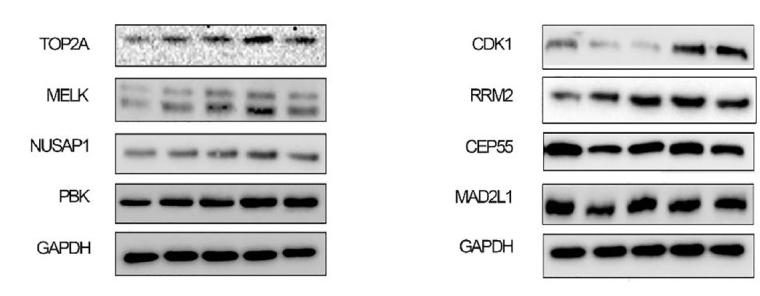TOP2A Antibody - #AF0793
| Product: | TOP2A Antibody |
| Catalog: | AF0793 |
| Description: | Rabbit polyclonal antibody to TOP2A |
| Application: | WB IHC IF/ICC |
| Cited expt.: | WB |
| Reactivity: | Human, Mouse |
| Prediction: | Pig, Sheep, Rabbit, Dog |
| Mol.Wt.: | 174kDa; 174kD(Calculated). |
| Uniprot: | P11388 |
| RRID: | AB_2834111 |
Related Downloads
Protocols
Product Info
*The optimal dilutions should be determined by the end user.
*Tips:
WB: For western blot detection of denatured protein samples. IHC: For immunohistochemical detection of paraffin sections (IHC-p) or frozen sections (IHC-f) of tissue samples. IF/ICC: For immunofluorescence detection of cell samples. ELISA(peptide): For ELISA detection of antigenic peptide.
Cite Format: Affinity Biosciences Cat# AF0793, RRID:AB_2834111.
Fold/Unfold
alpha isozyme; ATP hydrolyzing DNA topoisomerase II alfa; DNA gyrase; DNA topoisomerase (ATP hydrolyzing); DNA topoisomerase 2 alpha; DNA topoisomerase 2-alpha; DNA topoisomerase II 170 kD; DNA topoisomerase II alpha isozyme; DNA topoisomerase II; DNA Topoisomerase2; TOP 2A; TOP2; TOP2A; TOP2A_HUMAN; Topoisomerase DNA II alpha 170kDa; TP2A;
Immunogens
A synthesized peptide derived from human TOP2A, corresponding to a region within the internal amino acids.
- P11388 TOP2A_HUMAN:
- Protein BLAST With
- NCBI/
- ExPASy/
- Uniprot
MEVSPLQPVNENMQVNKIKKNEDAKKRLSVERIYQKKTQLEHILLRPDTYIGSVELVTQQMWVYDEDVGINYREVTFVPGLYKIFDEILVNAADNKQRDPKMSCIRVTIDPENNLISIWNNGKGIPVVEHKVEKMYVPALIFGQLLTSSNYDDDEKKVTGGRNGYGAKLCNIFSTKFTVETASREYKKMFKQTWMDNMGRAGEMELKPFNGEDYTCITFQPDLSKFKMQSLDKDIVALMVRRAYDIAGSTKDVKVFLNGNKLPVKGFRSYVDMYLKDKLDETGNSLKVIHEQVNHRWEVCLTMSEKGFQQISFVNSIATSKGGRHVDYVADQIVTKLVDVVKKKNKGGVAVKAHQVKNHMWIFVNALIENPTFDSQTKENMTLQPKSFGSTCQLSEKFIKAAIGCGIVESILNWVKFKAQVQLNKKCSAVKHNRIKGIPKLDDANDAGGRNSTECTLILTEGDSAKTLAVSGLGVVGRDKYGVFPLRGKILNVREASHKQIMENAEINNIIKIVGLQYKKNYEDEDSLKTLRYGKIMIMTDQDQDGSHIKGLLINFIHHNWPSLLRHRFLEEFITPIVKVSKNKQEMAFYSLPEFEEWKSSTPNHKKWKVKYYKGLGTSTSKEAKEYFADMKRHRIQFKYSGPEDDAAISLAFSKKQIDDRKEWLTNFMEDRRQRKLLGLPEDYLYGQTTTYLTYNDFINKELILFSNSDNERSIPSMVDGLKPGQRKVLFTCFKRNDKREVKVAQLAGSVAEMSSYHHGEMSLMMTIINLAQNFVGSNNLNLLQPIGQFGTRLHGGKDSASPRYIFTMLSSLARLLFPPKDDHTLKFLYDDNQRVEPEWYIPIIPMVLINGAEGIGTGWSCKIPNFDVREIVNNIRRLMDGEEPLPMLPSYKNFKGTIEELAPNQYVISGEVAILNSTTIEISELPVRTWTQTYKEQVLEPMLNGTEKTPPLITDYREYHTDTTVKFVVKMTEEKLAEAERVGLHKVFKLQTSLTCNSMVLFDHVGCLKKYDTVLDILRDFFELRLKYYGLRKEWLLGMLGAESAKLNNQARFILEKIDGKIIIENKPKKELIKVLIQRGYDSDPVKAWKEAQQKVPDEEENEESDNEKETEKSDSVTDSGPTFNYLLDMPLWYLTKEKKDELCRLRNEKEQELDTLKRKSPSDLWKEDLATFIEELEAVEAKEKQDEQVGLPGKGGKAKGKKTQMAEVLPSPRGQRVIPRITIEMKAEAEKKNKKKIKNENTEGSPQEDGVELEGLKQRLEKKQKREPGTKTKKQTTLAFKPIKKGKKRNPWSDSESDRSSDESNFDVPPRETEPRRAATKTKFTMDLDSDEDFSDFDEKTDDEDFVPSDASPPKTKTSPKLSNKELKPQKSVVSDLEADDVKGSVPLSSSPPATHFPDETEITNPVPKKNVTVKKTAAKSQSSTSTTGAKKRAAPKGTKRDPALNSGVSQKPDPAKTKNRRKRKPSTSDDSDSNFEKIVSKAVTSKKSKGESDDFHMDFDSAVAPRAKSVRAKKPIKYLEESDEDDLF
Predictions
Score>80(red) has high confidence and is suggested to be used for WB detection. *The prediction model is mainly based on the alignment of immunogen sequences, the results are for reference only, not as the basis of quality assurance.
High(score>80) Medium(80>score>50) Low(score<50) No confidence
Research Backgrounds
Control of topological states of DNA by transient breakage and subsequent rejoining of DNA strands. Topoisomerase II makes double-strand breaks. Essential during mitosis and meiosis for proper segregation of daughter chromosomes. May play a role in regulating the period length of ARNTL/BMAL1 transcriptional oscillation (By similarity).
Phosphorylation has no effect on catalytic activity. However, phosphorylation at Ser-1106 by CSNK1D/CK1 promotes DNA cleavable complex formation.
Cytoplasm. Nucleus>Nucleoplasm.
Note: Generally located in the nucleoplasm.
The N-terminus has several structural domains; the ATPase domain (about residues 1-265), the transducer domain (about 266-428) and the toprim domain (455-572) (PubMed:25202966). Comparing different structures shows ATP hydrolysis induces domain shifts in the N-terminus that are probably part of the mechanism of DNA cleavage and rejoining (PubMed:25202966).
Belongs to the type II topoisomerase family.
Research Fields
· Human Diseases > Drug resistance: Antineoplastic > Platinum drug resistance.
References
Application: WB Species: Human Sample: breast cancer tissue
Restrictive clause
Affinity Biosciences tests all products strictly. Citations are provided as a resource for additional applications that have not been validated by Affinity Biosciences. Please choose the appropriate format for each application and consult Materials and Methods sections for additional details about the use of any product in these publications.
For Research Use Only.
Not for use in diagnostic or therapeutic procedures. Not for resale. Not for distribution without written consent. Affinity Biosciences will not be held responsible for patent infringement or other violations that may occur with the use of our products. Affinity Biosciences, Affinity Biosciences Logo and all other trademarks are the property of Affinity Biosciences LTD.


